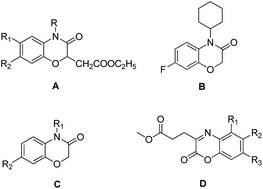Antibiotic activities of propanolamine containing 1,4-benzoxazin-3-ones against phytopathogenic bacteria†
Abstract
Various 1,4-benzoxazin-3-one derivatives containing propanolamine groups have been shown to exhibit good antibacterial activity against Pseudomonas syringae pv actinidiae (Psa), X. axonopodis pv citri (Xac) and Xanthomonas oryzae pv oryzae (Xoo). 1,4-benzoxazin-3-one 4n showed the best inhibitory effects against Psa, Xac and Xoo, exhibiting in vitro EC50 values of 4.95, 4.71 and 8.50 μg mL−1, respectively. These potencies were superior to the corresponding EC50 values of the commercial antibiotics bismerthiazol (BT, 89.10, and 116.90 μg mL−1) and thiodiazole copper (TC, 127.30, 82.73 and 87.50 μg mL−1). Treatment on the bacterial leaf blight of rice revealed that compound 4n displayed better curative (51%) and protective (48%) activities for reducing rice BLB than either BT (41%, 39%) or TC (43%, 41%). Scanning electron microscopy (SEM) imaging of Xoo that had been treated with 1,4-benzoxazin-3-one 4n (50–100 μg mL−1) revealed that the bacterial cells had experienced extensive cell wall damage, which is the likely cause of its antimicrobial activity and bacterial death.



 Please wait while we load your content...
Please wait while we load your content...